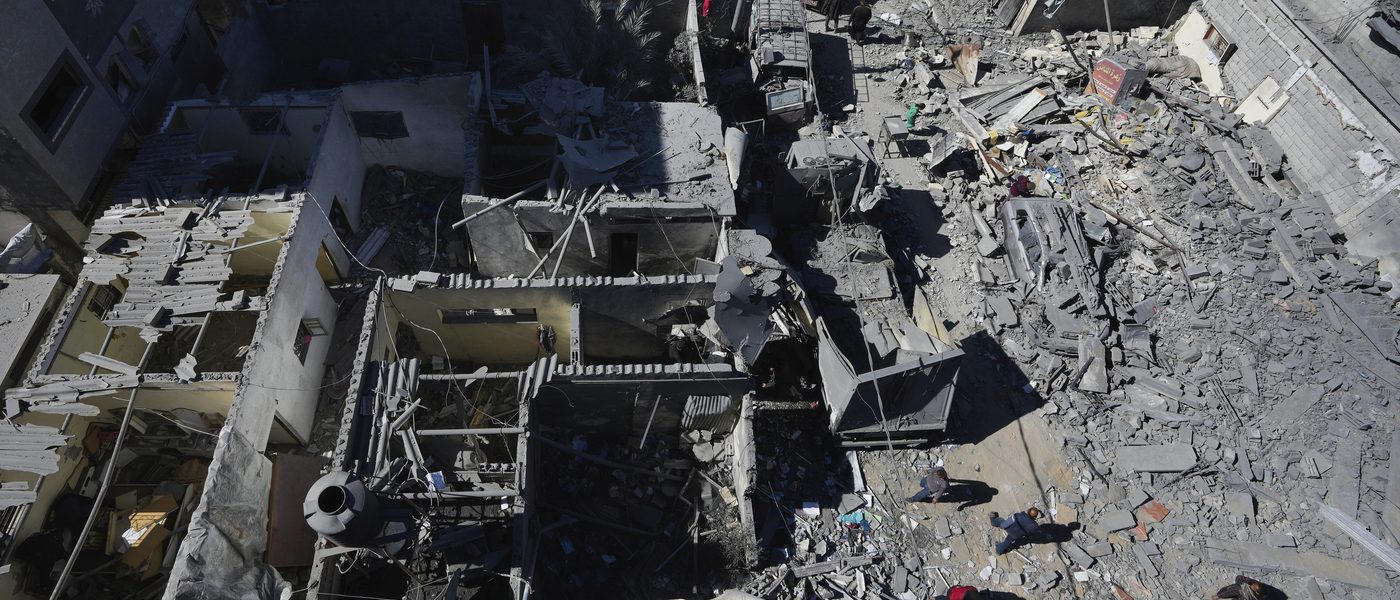Gaza has been under sieve since Israel launched its offensive against Hamas in August of the December 8th Israeli Retombment Massacre in the West Bank
Since launching its assault on Gaza, Israel has only allowed a trickle of food, water, medicine and other supplies into the south from Egypt at the Rafah crossing. Despite international calls to allow in more aid, the number of supply trucks is far less than the 500 that came in daily before the war.
The World Food Program said earlier this month that it was pausing deliveries to the north because of the growing chaos, after desperate Palestinians emptied a convoy while it was en route.
Hundreds of thousands of Palestinians are believed to remain in northern Gaza despite Israeli orders to evacuate the area in October, and many have been reduced to eating animal fodder to survive. The U.N. says 1 in 6 children under 2 in the north suffer from acute malnutrition and wasting.
Meanwhile, U.N. officials have warned of further mass casualties if Israel follows through on vows to attack the southernmost city of Rafah, where more than half of Gaza’s population of 2.3 million has taken refuge. What remains of aid operations could be in jeopardy if an offensive begins in the Rafah area.
Violence has also surged across the West Bank since Oct. 7. The Israeli military said two Israelis were killed at a gas station in Eli on Thursday. The military said that the attacker was dead.
The number of deaths since Israel launched its military offensive against Hamas in Gaza had already surpassed the tolls of any previous Arab conflict with Israel when it rose above 20,000 in December. Many experts say the official toll is very likely an undercount, given the difficulty of accurately tallying deaths amid unrelenting fighting, communications disruptions, a collapsing medical system and people still believed to be under rubble.
The Gazan health ministry doesn’t distinguish between civilians and fighters. Many international observers think the overall toll from the ministry is reliable, while the proportion of Hamas fighters among those killed does not appear to be clear.
Most of the patients that the Al-Awda Hospital received were shot, according to the acting director. He said the hospital can perform only the most essential surgeries because it is running out of fuel to power emergency generators.
The violence came more than a month after witnesses and health officials in Gaza accused Israeli troops of firing on a previous aid distribution in Gaza City, killing at least 20 people.
The Hamas-Israeli cease-fire after the Oct. 7 attack: Palestinian, U.S., Egypt, and Qatar urged the international community to act swiftly
Another man in the crowd — who gave only his first name, Ahmad, as he was being treated at a hospital for gunshot wounds to the arm and leg — said he waited for two hours before someone with a horse-drawn cart had room to take him to Shifa.
Medics arriving at the scene of the bloodshed Thursday found “dozens or hundreds” lying on the ground, according to Fares Afana, the head of the ambulance service at Kamal Adwan Hospital. He said there were not enough ambulances to collect all the dead and wounded and that some were being brought to hospitals in donkey carts.
The increasing alarm over hunger across Gaza has fueled international calls for a cease-fire, and the U.S., Egypt and Qatar are working to secure a deal between Israel and Hamas for a pause in fighting and the release of some of the hostages Hamas took during its Oct. 7 attack.
Saudi Arabia, Egypt, and Jordan all accused Israel of targeting civilians. In separate statements, they called for increased safe passages for humanitarian aid. They urged the international community to exert pressure on Israel to uphold international law and agree on a cease-fire.
Salem said the crowd, desperate for food, dispersed when an Israeli tank appeared. After it retreated, they came back to destroy the trucks. He said that after the Israeli soldiers opened fire. Israel said it had tanks to protect the convoy of private contractors.
Kamel Abu Nahel, who was being treated for a gunshot wound at Shifa Hospital, said he and others went to the distribution point in the middle of the night because they heard there would be a delivery of food. He said they had been eating animal feed for two months.
The Gaza War: A State of Emergency, Preventing Natural Disasters, and Implications for the United Nations and for the Dialogue of Hamas
The violence was quickly condemned by Arab countries, and U.S. President Joe Biden expressed concern it would add to the difficulty of negotiating a cease-fire in the nearly five-month conflict.
The director-general of the World Health Organization made a post on Thursday saying that most of the deaths in Gaza were women and children.
She said one Save the Children staffer in Gaza reported that doctors were sending premature infants to die because they did not have incubators to treat them. The aid groups said at least six children died so far from lack of food and it was the only food available.
Hamas is open to making a deal with Israel but is also ready to continue fighting, the political leader said in a televised speech on Wednesday. He called on Palestinians to march to the Aqsa mosque compound in Jerusalem in March, raising the prospect of fresh clashes with Israeli security forces around a site holy to both Muslims and Jews.
Israel has come under increasing pressure to stop its offensive, and even the strongest ally, President Biden, expressed his disgust at the growing death toll in Gaza. But Israeli leaders have insisted that they will continue fighting in order to eliminate Hamas, the armed group that led the Oct. 7 attack on Israel in which officials say at least 1,200 people were killed and 240 others taken hostage, setting off the war.
The death toll in Gaza passed a somber milestone on Thursday as the local health ministry reported that more than 30,000 people had been killed in the war since Oct. 7.
How to become a supercommunicator: How to communicate effectively and effectively with your fellow citizens in a country where there are too many people killed while seeking aid
The funeral of opposition leader Alexei Navalny is expected to take place today in Moscow. Navalny died two weeks ago under mysterious circumstances in an Arctic prison colony. His widow, Yulia, says her husband was murdered on orders of Russian president Vladimir Putin. The Kremlin has denied the accusation and insists it has no interest in Navalny’s funeral proceedings.
Scientists are trying to clone genetically modified pigs to have organs for transplant. Biotech company Revivicor Inc. says the experiments hold promise for alleviating the chronic shortage of organs for transplantation. The research has ethical and safety concerns.
Have you ever had a simple conversation that was easy to understand? Was it more interesting or understood to you? You could have been speaking to a supercommunicator, someone who’s consistently able to create authentic connections just by listening and talking. Charles Duhigg, a journalist, says anyone can become a supercommunicator. His new book breaks down skills to master if you want to bond with others in more profound ways:
Source: Navalny’s funeral draws police presence; over 100 in Gaza killed while seeking aid
NPR’s Guide to Oscars: How to keep up with FX’s adaptation of Shgun, NBC’s Shgun and Crosley’s Grief is for People
There are five films nominated for an Oscar for best international feature. But if you can’t see them before the ceremony on March 10th, NPR’s guide will tell you enough to keep up at your Oscars party.
NBC’s Shgun from the 1980s is still on TV today. FX’s latest adaptation is sexier, more violent and even more thought-provoking and illuminating than the original. You can’t go wrong with watching both.
Books: Critic Heller McAlpin writes that Sloane Crosley’s first full-length nonfiction book, Grief is for People, is a “meditation on loss and grief that combines her verbal alacrity and mordant wit with moving descriptions that capture the ache of sleepless nights.”
The second part of the Final Fantasy remake series is out today and is hitting some incredible highs. Andy Bickerton says that when the game works, it’s amazing. But when it does not move, it drags.
I still haven’t gotten all of them on one of the weekly NPR news quizzes. Perhaps my clue will help you ace it: not every photo is related to the answer.
Source: Navalny’s funeral draws police presence; over 100 in Gaza killed while seeking aid
Israel’s ambassador to the U.N. Security Council on the September 7 Gaza attack: “We are sending rations to Jordan, not the United Arab Emirates,” he added
Good morning. You’re reading the Up First newsletter. Subscribe here to get it delivered to your inbox, and listen to the Up First podcast for all the news you need to start your day.
Soeripto, from Save the Children says that they have been calling for more crossing hours, more capacity to check the trucks and more time to unload them. It is easy to make the logistics of the operation simpler and less painful. And none of these have been taken up so far.”
Israel’s deputy permanent representative to the U.N. Security Council said his government was committed to improving access at the Rafah border crossing and reactivating another land crossing at Kerem Shalom in Israel.
The lack of aid is due to U.N inefficiency, according to Israel. Israel has accused, without providing evidence, a dozen employees of the U.N. agency that’s the main aid group for Palestinians, UNRWA, of participating in the Oct. 7 attack. The claim prompted many donors, including the United States, to withhold much-needed funding. The European Commission on Friday said it welcomed an UNRWA investigation into the allegations and was restoring funding.
About 26% of Gaza’s population, more than 570,000 people, were “one step away from famine,” the UN’s humanitarian agency told the Security Council.
Jordan this week dropped other, waterproof boxes of rations into the sea off the Gaza coast where people waded into the water or set off on small boats to retrieve them.
On the airfield on Thursday, photographers were prevented from photographing the flag of another Arab country on one of the pallets; saying it was one of two Arab nations participating in the airdrops that day that did not want their participation publicized. On the tarmac was a Qatari cargo plane that had intended to participate in an airdrop before it developed mechanical problems.
The kingdom has operated a field hospital in Gaza for many years and so far has carried out more than two dozen aid drops. It says seven airdrops taking off from Jordanian air bases have been conducted by partner countries, including France, the United Kingdom and the United Arab Emirates.
On the tarmac at the King Abdullah II air base near the city of Zarka, more pallets were waiting to be loaded by Jordanian military personnel onto cargo planes for drops later in the day. Amman’s national dish, mansaf, made of lamb, dried yogurt and rice, was featured in the meals that were similar to military meals ready to eat.
The pallets of food couldn’t be seen where they were sent over northern Gaza. The unpredictability of the meticulously planned airdrops is still a subject of concern. Jordan’s military said while most of the pallets dropped Thursday landed in northern Gaza, the wind had blown one of them across the border into Israel.
Israel has barred foreign journalists from Gaza since the start of the war, except for rare instances when it has escorted them. That, along with disrupting phone and internet service, makes it extremely difficult to confirm what is happening on the ground. At the same time, Israeli strikes have killed at least 122 local journalists and media workers in Gaza since October, according to U.N. reports.
In his statement Friday, the U.K. foreign secretary said that it was unacceptable that only half of the trucks crossed into Gaza in February.
Supplies to people in need are hard to get and to do that safely and securely is very difficult.
Source: Aboard Jordan’s aid airdrop over Gaza, a last resort for relief to Palestinians there
Hamas, Medical Supplies, and Health: The Israeli Attack on Sept. 7 and Gaza’s Emergency Medical Services, reported by a Palestinian Journalist
The Israeli military says it has to search every vehicle for weapons that could be used by Hamas, the Palestinian group that attacked Israel on Oct. 7, killing 1,200 people and sparking the invasion of Gaza. In response to the attack, Israel launched a military campaign that has killed more than 30,000 civilians according to Gaza’s health ministry.
“This situation is the direct result of the string of unconscionable decisions taken by Israeli authorities while waging this war: a relentless bombing and shelling campaign, a complete siege imposed on the enclave, the bureaucratic hurdles and lack of security mechanisms to ensure safe food distribution from southern to northern Gaza, the systematic destruction of livelihood capacities such as farming, herding and fishing,” Doctors Without Borders said in a statement after the killings near the aid trucks.
On Friday, a Palestinian journalist in the Gaza Strip posted on the social networking site X stating that thousands of Palestinians were at the same spot where civilians were killed on Thursday.
Like many in Gaza, Salem spends much of his day walking miles trying to find food for his three children, his wife and his mother. Even for those with money, there is no food available to buy.
With the most of Gaza’s infrastructure destroyed by Israel, there are only a few hospitals and ambulance services which are trying to operate without basic medical supplies. Salem, like other casualties, was taken to hospital by horse-drawn cart.
Israel acknowledges that it opened fire in what it said was self-defense but said most of the dead were killed after being run over by the trucks or trampled in a stampede.
Jordanian air force personnel unhook the chains in the air to allow the boxes to roll from the cargo door.
Gaza deaths for next six months projected in first-of-its-kind effort: “Excess deaths’ in Gaza for next 6 months”
Spagat says that he has less trust in what the Ministry of Health is releasing because it’s worse quality. He thinks that there might be more deaths going uncounted than with the beginning of the war. The numbers are reasonable to use. Honestly there’s no other alternative.”
The researchers think fighting stops immediately in the ceasefire scenario. Even though no more people would die from traumatic injuries because of active warfare in that scenario, there would be still deaths from injuries sustained prior to the ceasefire. And civilians would continue to inadvertently set off unexploded ordnance as they try to rebuild Gaza. Estimating deaths alone is not easy.
That data is messy and imperfect but better than data from other conflicts, says Spiegel. It’s rare to have baseline data that’s so strong, like the number of people killed in past Gaza conflicts or immunization levels that can advise estimates of how deadly a disease outbreak might be. Still, the researchers include a range of possible values for each number they project to reflect uncertainty in their estimates.
For six months of war comparable to the early stages, they took the average casualties from October 15 through January 15 and spun them forward over the next six months. For escalation, they assumed fighting from now through August would be as intense as October 11 through November 10, the worst month of the conflict so far that claimed more than 11,000 lives.
He says thatEscalation could involve indiscriminate bombing of densely populated areas, or Israeli forces could use water to flood the tunnels. We don’t know what the armed groups actions will be in any of those scenarios.
Between 74 and 85 million deaths could be added if the war escalates. (The higher number in each range includes deaths from possible outbreaks of infectious disease).
Estimates of trauma deaths from the Allied bombs in Dresden and the Nazi bombs in London during World War II can be seen, as well as the estimated 40,000 lives taken in London over eight months.
Source: ‘Excess deaths’ in Gaza for next 6 months projected in first-of-its-kind effort
The ‘Excess deaths’ in Gaza for next 6 months projected in first-of-its-kind effort: NJ: A medical journalist on bluesky and on X
This is a very preliminary report. New data including measures of mental health will be included in the updated projections that will be released over the next several months.
“I hope we’ve made clear that there’s still going to be a lot of death if there’s a ceasefire,” says Spiegel, underlining the importance of getting adequate food, water and medical attention to where it’s needed as soon as possible. blockades, assaults and damaged roads are preventing aid from reaching those who need it.
“These quantitative, evidence based efforts are useful in making politicians and humanitarian agencies face the human cost of continued fighting,” says Asi. “But that’s just the first step. They need to be with advocacy and political action.
Jonathan is a health and policy journalist based in D.C. He’s been a staff writer at Grid and Science News and has contributed to NPR, Nature News, Quanta Magazine and the Dallas Morning News. He obtained a Master’s degree from Cornell University. He can be followed by following either on bluesky or on X.
Source: ‘Excess deaths’ in Gaza for next 6 months projected in first-of-its-kind effort
The possible toll of an outbreak in Syria from best- to worst-case scenarios with and without infectious diseases: a multi-state study of Israel-Gaza conflict
To estimate the possible toll of an outbreak, the team combined existing data on baseline health status, malnutrition, sanitation and vaccination rates with models of infectious disease spread. Researchers say that an outbreak would be very hard on children, because they are more vulnerable to infections. More than half a million people are “facing catastrophic levels of deprivation and starvation,” according to the United Nations.
Infectious disease outbreaks, like cholera or COVID, are common in conflict zones, as overcrowding in shelters and poor sanitation can stoke the spread of pathogens. It is difficult to estimate when an outbreak might happen, which is the reason that the projections were made with and without epidemics.
The researchers decided to scope out three scenarios for how the Israel-Gaza war might unfold over the next six months, from best- to worst-case. They predicted how many people would die from a number of diseases, from trauma to infectious disease to non-communicable diseases.
3,250 people will die from traumatic injuries after fighting stops, according to the researchers. A total of 6,550 to 11,580 deaths have been caused by non-violent causes.
“We have to think about how the health-care system is changing over time,” says Spiegel. The situation right now is dire, according to many of the trauma doctors the researchers consulted for the study. “If hospitals are functioning, a person with a head or chest wound might survive. But in the current situation, it’s likely that he or she will not.”
Constructing those two extreme scenarios — ceasefire and escalation — as well as a status quo middle ground, required making a lot of assumptions. To inform the assumptions, the researchers gathered up all the data they could find from the conflict so far, filling in the gaps with information from other conflicts as well as consultation with trauma doctors.
“We wanted to define scenarios that were realistic and then based on those scenarios project what might happen, giving us some [upper and lower] bounds to work with,” says Tak Igusa, a civil engineer at Johns Hopkins University.
“I’ve spent my career looking backward and trying to calculate the cost of war that’s wrapped up,” says Ball. I can envision a whole new field coming from this, but I’m never projecting tomorrow’s deaths. We’re always going to be doing this.
Other people agree. “It’s a rigorous way of assessing the human cost of human decisions,” says Patrick Ball, the director of research for the Human Rights Data Analysis Group. The kind of speculative projections that can be useful in clarifying the potential costs of military action, is something that he stresses is beyond the purview of the projections.
“It shows that even if the bombing stops tomorrow, people will continue to die, not simply from the destruction of the health-care system but [loss of] access to food, water, vaccinations and shelter,” she says. Even if the numbers are not perfect we have to confront what this means for the population there. We can’t say we didn’t anticipate this.
Yara Asi, a public health expert who studies the health effects of war at the University of Central Florida and was not involved in the analysis, stated that there’s no perfect methodology for projecting. She thinks it’s innovative and valuable.
The chaos of war usually means that researchers wait until a conflict is over to pore over the data and reconstruct as complete a picture as they can of how many lives were lost and what took them.




